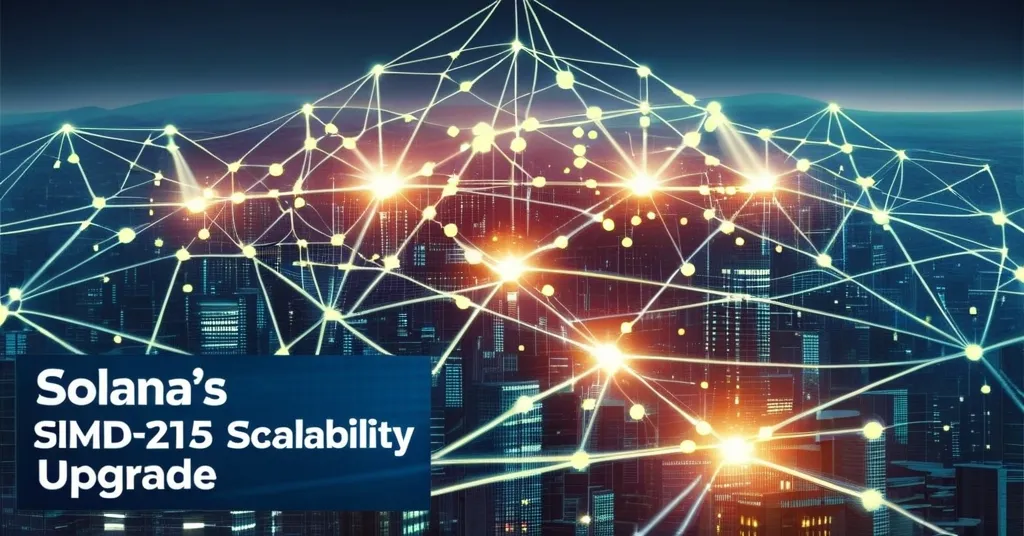Solana’s SIMD-215 Proposal Aims to Boost Scalability to Billions of Accounts

Solana’s SIMD-215 Proposal: A Leap Forward in Blockchain Scalability
Solana is poised to redefine the limits of blockchain scalability with its SIMD-215 proposal, aiming to manage billions of accounts with unprecedented efficiency. This bold move could not only supercharge Solana’s network but also set a new benchmark for the entire blockchain industry.
- Solana’s SIMD-215 aims to handle billions of accounts
- Introduces lattice-based homomorphic hashing function
- Potential to set new standard for blockchain scalability
At the heart of Solana’s ambitious plan is the SIMD-215 proposal, which introduces a lattice-based homomorphic hashing function. This might sound like the tech equivalent of a secret recipe, but it’s essentially a new way to verify accounts more efficiently. Imagine scaling a city’s population from a small town to a bustling metropolis without the usual traffic jams. That’s what SIMD-215 promises to do for Solana.
The goal? To scale the network to handle billions of accounts while computing a ‘hash of all accounts’ in practical time and space. Anatoly Yakovenko, the co-founder of Solana Labs, has been vocal about the challenges of the ‘state growth problem,’ where new account creation becomes a resource hog. “The problem comes down to this simple thing: New account creation has to create new accounts. This means that a new account has to prove that it is new somehow. This is trivial to do if the runtime has a full global index of all the accounts. But that kind of way of proving that the account is new is expensive. Every node has to have a full index of all the accounts in the runtime,” Yakovenko explained.
So, how does this lattice-based homomorphic hashing function work its magic? It removes the need for a new account to prove its newness by allowing the network to update its state verification by only processing changed accounts. This not only maintains a robust 128-bit security level but also slashes the computational overhead, making the network more efficient and less like a resource-guzzling monster.
The upgrade will be rolled out through Solana’s formal improvement process, with a gradual rollout to ensure nodes can pre-compute the new system before flipping the switch to full activation. This careful approach aims to prevent any hiccups that could come from such a significant change.
While the proposal sounds like a dream come true, it’s not without its potential challenges. Implementing a new hashing function is no easy feat, and there could be bumps along the road, especially for existing applications and users. However, if successful, SIMD-215 could set a new standard for blockchain scalability, influencing other networks to follow suit.
For everyday users, this upgrade could mean faster transaction speeds and lower costs, making Solana an even more attractive platform for developers and users alike. But as with any technological leap, we must remain cautiously optimistic, keeping an eye on how this upgrade unfolds in the real world.
While Solana’s SIMD-215 proposal is a bold move, it’s worth noting that previous scalability solutions have faced unexpected challenges. The crypto world is full of surprises, and while we champion the spirit of disruption and acceleration, we can’t ignore the potential dark corners this new path might lead us down. Let’s celebrate the promise of this upgrade while staying alert to the realities of implementation.
As we watch this proposal unfold, it’s clear that Solana is not content to rest on its laurels. With SIMD-215, the network is pushing the boundaries of what’s possible in blockchain scalability. And while we’re all for disrupting the status quo and accelerating the future of decentralized tech, let’s not forget to keep our eyes peeled for any dark corners this new path might lead us down. After all, in the world of crypto, optimism must always be tempered with a healthy dose of realism.
“The main goal is to scale Solana to billions of accounts and compute a ‘hash of all accounts’ in practical time and space.”
“The problem comes down to this simple thing: New account creation has to create new accounts. This means that a new account has to prove that it is new somehow. This is trivial to do if the runtime has a full global index of all the accounts. But that kind of way of proving that the account is new is expensive. Every node has to have a full index of all the accounts in the runtime.” – Anatoly Yakovenko, Solana Labs co-founder
“Think of it like cleaning a house. Instead of scrubbing every single room every day, you only tidy up the spaces that got messy. This saves time and effort while keeping everything in order.” – Republik Labs on the proposal
Key Questions and Takeaways
- What is the main goal of the SIMD-215 proposal?
The main goal is to scale Solana to billions of accounts and compute a ‘hash of all accounts’ efficiently. - How does the lattice-based homomorphic hashing function change account verification on Solana?
It allows the network to update its state by only processing changed accounts, reducing computational overhead. - What is the ‘state growth problem’ in blockchain networks?
The increasing demand on network resources as the number of user accounts grows. - What security level does the new system maintain?
A 128-bit security level. - How will the upgrade be implemented on Solana?
Through Solana’s formal improvement process with a gradual rollout. - What potential challenges might the SIMD-215 proposal face?
Implementation difficulties and potential hiccups for existing applications and users. - What are the potential benefits for users and the broader crypto ecosystem?
Faster transaction speeds, lower costs, and setting a new standard for blockchain scalability.



